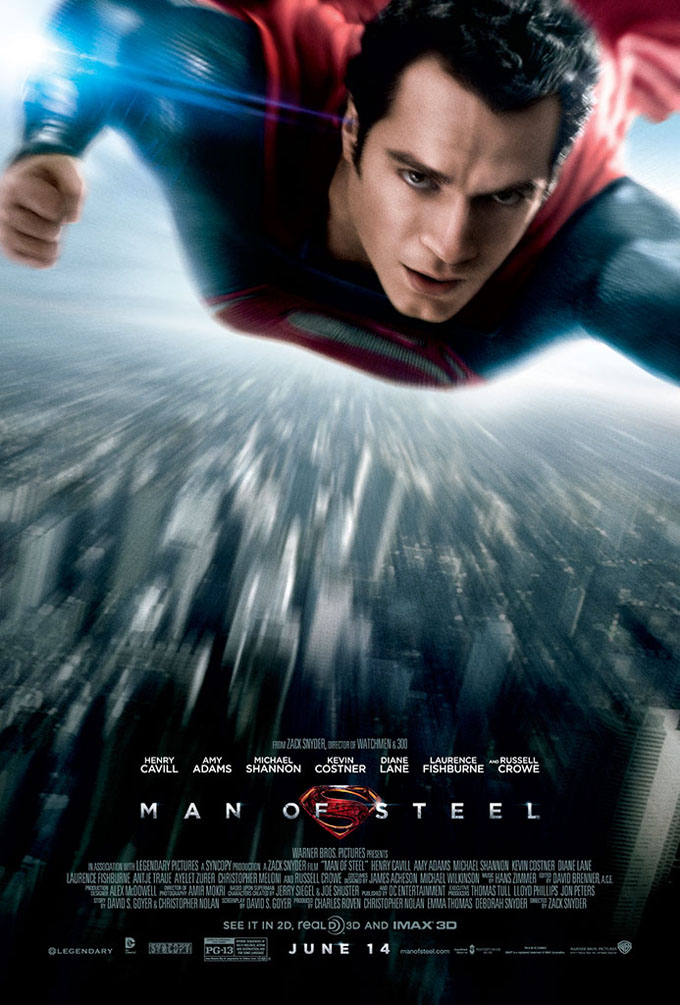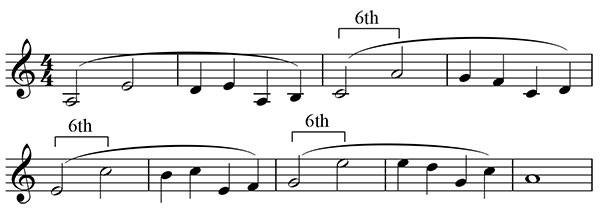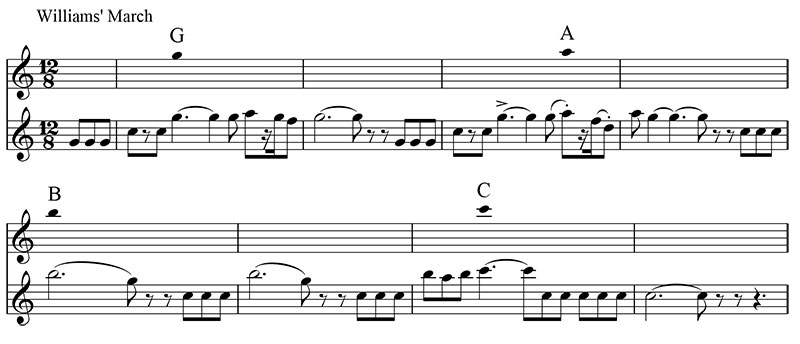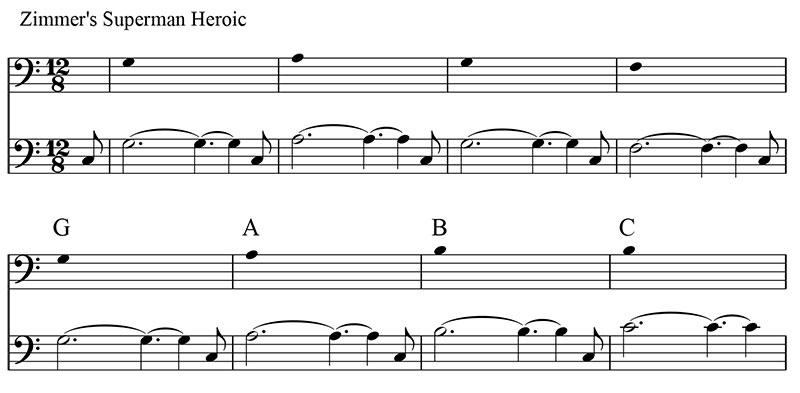
2013’s Man of Steel takes quite a different approach to the Superman story than 1978’s well known Superman: The Movie. The latter film is largely optimistic in tone, lighthearted, and includes touches of humor. Indeed, when John Williams scored the film, he remarked that one of the things he liked about it was that “it was fun and didn’t take itself too seriously.” Williams’ vibrant score certainly reflects this element of fun while also capturing the film’s optimism in grand heroic fashion.
Man of Steel, on the other hand, deals more with the philosophical questions of being an outsider. Desperately wanting to fit in with the rest of society, Superman is continually faced with a dilemma: if he reveals his powers to the people of the world, then he’ll no longer be considered one of them. But if he is to retain his “fit” with society, then he can no longer rescue anyone with the help of his powers. This different kind of Superman film calls for a different kind of Superman score, and that is exactly what Hans Zimmer provides.
Although Zimmer’s score does not make use of strict leitmotifs, which correlate a short snippet of melody with a certain character, place, object, and the like, it does exhibit a loose coordination between certain themes and situations involving certain characters. For this reason, it can be difficult to put a label on Zimmer’s themes and they must often be given a more descriptive title than simply the name of a character or place in the film. Another feature of this particular score is the way in which many of its themes are given dual meanings that are either opposites or complements of one another. Below is a film music analysis that examines these aspects of several themes in the film.
Jor-El / Kal-El

This ostinato is the first theme we hear in the film as it sounds over the production credits, before the film proper is underway. The theme reflects a duality in meaning since, with practically every instance of the theme, we see either Jor-El (Superman’s biological father from Krypton) or Kal-El (Superman, as he is called on Krypton), even though the theme is not associated with any particular type of action they take. Near the start of the film, for example, as Jor-El heroically escapes on a dragon-like creature with the “codex” (an object that contains the genetic code of the entire population of Krypton), we hear this theme stated boldly in the brass (from 1:18):
The theme also appears in some scenes where Jor-El’s focus is on Kal-El, as when the baby Kal-El is raised into the escape pod near the film’s start (from 1:42):
…and when Jonathan Kent (Superman’s foster father on Earth) shows Clark (Kal-El) the escape pod in which he arrived on Earth (from 1:49):
The association between this theme and the characters is therefore quite loose—it doesn’t always signify any one particular emotion or situation with these characters. Rather, it seems to be more of a main theme for the film to be used flexibly in relation to Jor-El and Kal-El. In fact, one could even read into it an attempt to reinforce the Christ-like portrayal of Superman (a god-like being whose goal is to save humanity) by sounding the theme with the “holy trinity”: Jor-El (the father), Kal-El (the son), and Jor-El’s ghost (the “holy” spirit). This connection is strengthened by the fact that this theme is closely related to the Superman “heroic” theme in its triplet-based rhythms, its rising motifs, and the relatively large intervals. Compare the two below:


The relationship between these two themes is even further strengthened by sometimes having one directly follow the other within the same cue, as in the first two minutes of “Look to the Stars”, in which Jor-El/Kal-El is heard over the production credits then Superman Heroic (described below) enters with the start of the film proper at 1:03:
Superman Heroic
In addition to Jor-El/Kal-El, Superman has two other themes that are essentially different forms of the same theme, hence forming another of the score’s dualities. One of these generally accompanies Superman in positive situations in which he is overcoming some sort of obstacle, either internally as he struggles to fit in with humanity, or externally in his battles with General Zod. For this reason, I call it Superman Heroic.
This theme opens the film proper as the baby Kal-El (Superman) is being born. Though Kal-El is not performing any heroics at this particular moment, the music acts something like a prophesy: one day, this child will accomplish great things.
Other instances of this theme can function in a similar way, as when Kal-El gets his first glimpse of his iconic outfit, given to him by Jor-El. Kal-El’s donning of the suit takes him a big step further towards “an ideal to strive towards” that Jor-El believes he can become for the people of Earth.
In some instances, the theme is heard in a more overtly heroic context when Superman is battling Zod, although in these cases, the usual C major key of the theme is altered to C minor, giving the music more of a sinister sound that suggests the evil of Superman’s opponent (from 4:11):
At other times, it functions more as a theme to signify a victory for Superman over his own internal struggles. Examples include Superman’s voluntary surrender to the military (symbolically restrained in handcuffs that he could, and later does, easily snap in two), and his being hired at the Daily Planet as Clark Kent at the end of the film. In both cases, Superman is attempting to fit in more with society by complying with human expectations, first by turning himself in as the alien General Zod is looking for, then as a “typical” guy joining the workforce.
Emotionally, the theme evokes feelings of heroism, security, and hope, each of which can be attributed to an aspect of the music itself. The sense of heroism is evident in its prominent use of a rising perfect fifth. Its feeling of security derives from the use of a tonic pedal point, or the repetition of the key note of the scale (the tonic) throughout the theme, which anchors the theme to familiar musical ground even when the chords become strange and chromatic (at the entry of the synthesized voices at 1:46). And a sense of hope arises largely from the scoring of the theme’s melody for French horns, trombones, and cellos, which combine to give a plaintive yet strong sound when played softly as they are here.
Superman Introspective
The other form of Superman’s dual-natured theme is a close cousin of Superman Heroic, as the phrases involve the same intervals (fifths, sixths, and fourths) in the same dotted rhythm. Compare them below:
Here’s what the Superman Introspective theme sounds like:
And yet, despite these connections, the two forms of the theme differ greatly in meaning. Whereas Superman Heroic tends to accompany Superman in situations where he accepts the expectations placed on him and thus is fitting in with society, Superman Introspective tends to accompany him in opposite situations, when his own thoughts and desires are at odds with societal expectations, as for example when Clark:
- As a child, is overwhelmed by the abundance of stimuli his super-senses give him
- As a child, discusses with Jonathan (his foster father) Clark’s saving of a school busload of children and how to better “fit in” with society
- As a young adult, follows Jonathan’s signal not to save him from a fatal tornado because Jonathan believed the world was not ready for Clark’s superpowers
- As a full adult, discusses with a priest whether he should reveal his alien identity and turn himself over to General Zod (Superman’s enemy)
- Has his final memory of childhood, remembering his father (implying a recall of the tornado dilemma)
At these moments, Superman becomes introspective as he searches for a way to satisfy both his own desires and those of society. This emotional quality is created not only by the slow, contemplative rhythm of the theme, but also by its scoring for piano, which lends an intimacy to the sound, as though we are privy to the character’s tender, private thoughts.
Krypton’s Old Ways
This is another of the film’s dualistic themes that depicts Krypton’s opposing forces, one negative, destructive, and of the planet’s old way of thinking in which every Kryptonian is born for a specific societal purpose (as personified by Zod and his crew), the other positive, constructive, and of the new way of thinking in which Kryptonians are free to choose their own path in life (personified by Jor-El, his wife Lara, and Kal-El). The different emotional character of each is largely a result of the scoring. What I call Krypton’s Old Ways is an ostinato generally heard in the mid to low strings with rapidly repeating notes, suggesting something aggressive, as in the score and audio clip below (from 2:10):

This theme appears when Krypton’s old ways are being threatened, as when:
- Jor-El explains to the Council (which has not heeded his warnings up to this point) that the planet’s destruction is imminent due to their excessive mining of the planet’s core
- A machine under Zod’s authority tries to prevent Jor-El from escaping with the codex
- Zod breaks into Jor-El’s lab to retrieve the codex
- Lois and Jor-El’s ghost fight Zod and his crew on Zod’s ship (after Jor-El has changed the atmosphere on the ship from that of Krypton to that of Earth)
- Superman destroys Zod’s ship in the final battle
Krypton’s New Ways
This form of the Krypton theme is always scored much more lightly than the Old Ways theme. It features synthesized sounds in a higher register and in longer notes, a combination which suggests something benign, yet otherworldly, and even exploratory—all aspects of the new way of thinking. Hence I call this ostinato theme Krypton’s New Ways. We hear this theme in several scenes showing the effects of this new mode of thought, as when:
- Jor-El dives into the water and in search of the codex
- The baby Kal-El is launched off of Krypton in an escape pod
- Kal-El’s pod heads out to space towards Earth
- Superman floats (in Christ-like pose) in the water after the destruction of an oil rig (having saved the humans on board rather than killing them or letting them die as Zod and the “old way” would dictate)
- Lois examines a photo of Clark Kent going to the Kryptonian scout ship in the arctic (where he will meet Jor-El and obtain the new mode of thought directly from his father)
- Superman talks with Jor-El in the scout ship
Notice the close similarity between this and the Old Ways theme (from 0:07 in the clip below). Like the Jor-El/Kal-El theme, the Krypton themes also are juxtaposed—hear the Old Ways theme enter below at 0:48:

Suffering – Lament
Yet a third theme to exhibit a dual nature is one that suggests suffering of one kind or another. Its primary feature is that its melody is constructed largely out of a series of rising sixths, which, in a minor key (as here), are often used to depict tragic or troubled situations. I call the first form of the theme Lament since it is always scored plaintively in the French horn, or cello with voice, lending the scene a feeling of grief. It appears, for instance, when:
- Jor-El convinces Lara to part with their son and send him to Earth
- Lara mourns Jor-El’s death
- Lara utters her last words just before the destruction of Krypton
Here is the score and audio of the theme (from 0:55):

Suffering – Burden
The second form of the theme accompanies Superman’s second flight as he tests the limits of his powers in the desert. Just before he takes off, Jor-El’s voice is heard telling Superman that the people of Earth will follow his lead as an ideal to strive towards, but that it will take time. The sense of a psychological weight on Superman is clear not only from these words, but from his facial expressions as well. Hence I call this form of the suffering theme Burden. Although Zimmer leaves the melodic line as it was in the Lament theme, he does change its scoring, which is now much like Superman Heroic in that the melody is played by French horns and cellos, giving it a more uplifting sound (no pun intended). A new rhythmic accompaniment is also added, giving it a powerful sound. Hear it in the clip below from 2:59:
General Zod

This short ostinato has the tightest association of any theme in the film as it is connected only with General Zod and is almost always heard when he is onscreen or is being directly discussed. Its appearances include when:
- Zod enters the council chamber at start of film (where he is introduced to us)
- Zod and his crew are imprisoned and taken away
- Lois agrees to be taken captive in Zod’s ship
- Superman beats Zod up when he attacks Superman’s mother
- Zod and Faora (Zod’s second-in-command) have a standoff with Superman
- Zod and Superman fight for the last time
Here’s how it sounds (from 1:49, played in the strings):
The theme’s most distinctive feature is its use of what’s called the Phrygian mode, a kind of scale that’s like a minor scale but with a lowered second scale step—this is the characteristic sound of the Phrygian mode, and it gives the theme a dark, sinister character.
Comparison with John Williams’ Superman Theme
While the sound of Zimmer’s Man of Steel score is almost nothing like that of Williams’ famous score for Superman: The Movie, there are a number of resemblances that bear mentioning. Most obviously, Zimmer’s Superman Heroic theme opens with the same rising fifth as Williams’ Superman March, and in the same key of C major. But more subtly, the goal notes of the Heroic theme create melodic lines that are found in the March. The first five goal notes of the Heroic theme, for example, are G-A-G-F-G. These are the very same notes found in the opening of the March theme, as shown below:


Now compare the sound of each. Listen to the Williams March from 0:40-0:44:
Then listen to Zimmer’s Heroic theme from 1:03-1:32, which is much slower than the Williams, but still constructed with the same notes:
But there are more similarities to be found. In the Heroic theme, beginning from the second G, the goal notes are then G-A-B-C. This very same line underlies Williams’ March theme:


Now compare the sound of these passages. Hear the Williams from 0:45-0:57:
And hear Zimmer’s Heroic theme from 1:28-1:50, which, again, is much slower than the Williams, but retains the same goal notes in the melody:
More subtly, the two even share a common metre, with beats arranged into four groups of three (here, notated as 12/8 in Zimmer’s theme, which was transcribed by ear).
Even though the two themes have a very different feel, these striking relationships create a connection between them that one could rightly call homage. In short, there seems to be no doubt that, consciously or subconsciously, the Williams March had an influence on the creation of the Zimmer’s Heroic theme.
Conclusion
Many of the themes in Hans Zimmer’s score for Man of Steel are given dual meanings, generally one positive, the other negative, a distinction made clear by the instrumentation and rhythmic setting of the theme. In addition, the associations that the themes have are rather loose in that they signify the same character (or set of characters) in similar situations rather than simply signifying the character in the manner of traditional leitmotifs. While themes in films are usually altered in some way to reflect the changing emotions of the story, the two forms of each of the themes in Man of Steel are employed in such contrasting ways that they actually signify something different, at least on the surface. On a deeper level, the dualistic themes represent two aspects of the same idea, like two sides of the same coin. This is quite a different approach to film scoring, especially for a blockbuster such as this, but then, this is quite a different Superman film.

Many of the links have been pulled.
Wish I could take a listen.
I just tried them and they work for me. It must be something related to the country one is in. If you give me a link to a YouTube video of Man of Steel audio that works for you, I can try inserting those instead.
It was (as always) an inspiring post.
First I thought the score is that bad, reviews said. After this post I think different, especially of the dualistic Theme(s).
I hope your blog will exist as long as possible!
Greetings from Germany 😉
Thanks, Malte. I myself was surprised at how complex the use of the themes is. It was very different from Zimmer’s Dark Knight scores, but it still worked quite well.
I hope to keep the blog going too. It’s been eight months so far!
good analysis but why didn’t you talk about the last track on the album? It’s the superman theme in it’s fullest form.
Also the “Superman introspective” theme is the Clark Kent theme
@Dave: It’s really the brevity of these analyses that forces some themes to be left out. The one on the last track is the theme heard in the first flight sequence (combined with a brassy theme that scene didn’t have). I tried to keep the analysis on more pervasive themes in the film. That’s all, really.
About the Introspective theme, you could call it “Clark Kent”, but I think that would leave out something of the meaning of that theme. The funny thing is, these themes aren’t really leitmotifs in the traditional sense. So calling it “Clark Kent” would make it seem like it’s heard whenever that character is onscreen, something like, say, Darth Vader’s theme in the Star Wars movies. To me, the theme is more of a signal that Superman / Kal-El / Clark Kent (whichever you want to call him) is having trouble fitting in with human society and forces him to ponder things philosophically. Hence, the introspective name.
Also, “Superman Introspective” highlights the dual nature of the theme with the Heroic version more than, say, “Clark Kent Introspective” would (though that’s just as accurate).
Love your blog! The connection between Zimmer & Williams’ score you discovered is really interesting, Mark. Zimmer is really fond of deconstructivism ideas, which can also be found in Moriaty’s theme from Sherlock Holmes 2 or Inception etc
Thank you, Kevin! I’ll take a listen to Moriarty’s theme – haven’t yet seen Game of Shadows, but would like to soon. Inception’s a score that certainly deserves more attention, but I think it’s overshadowed by Zimmer’s Dark Knight music, being another collaboration with Christopher Nolan. “Time” is the cue everyone always raves about. Maybe I’ll do a post on that score sometime.
just a hint, for moriaty’s theme Zimmer used a piano phrase from schubert’s Die Forelle and changed it to a minor key in a much slower speed, then started to develop the whole theme, which is awesome! Indeed Inception is one of the best score from Zimmer, yet while “time” is a stunning piece, tracks with similar melody can be heard in some other Zimmer’s score like “The Thin Red Line”. But what I appreciate is how he manipulated these few simple cords according to concepts of dream and time. And of course the idea of deconstructing Piaff’s song into an iconic brass blast is phenomenal as well. And I will be expecting your post too!
For the record, if you do a posting on Inception (and if this is even important to you): the theme for Robert Fischer (album track 528491; many variations in the film) and the so-called “Kick It” theme (One Simple Idea on the album) were actually composed by Lorne Balfe, not Hans Zimmer. I’m just saying so that if you do an Inception post, you don’t make reference to “X Zimmer theme”, which Zimmer didn’t actually write. 😉
I found the stuff about Jor-El’s theme particularly intriguing. When I first heard it, I thought it was just Superman’s theme in one of many forms, but you’re right: it definitely denotes Jor-El as well. Thank you for a good read.
Also, have you thought of analyzing the themes in Zimmer’s Lone Ranger score?
I have heard that the score for Lone Ranger is a surprisingly tuneful one for Zimmer. I haven’t yet seen the film myself, but have heard the last track with the Rossini mix. I’ll have to hear it with the film because I’m not sure what to make of it on its own.
A friend directed me here and I am glad I visited 🙂
Thank you for all your hard work as my students will love your site for studying film music.
Just for fun, I drew up a plan to play the ‘Ideal of Hope’ theme on iPads here: http://www.slideshare.net/wrightstuffmusic/ideal-of-hope-ios-task
Thanks again.
Many thanks for your enthusiasm, Samuel. It’s much appreciated.
Wow, what a brilliant write-up. As always, there is so much more to Hans’ work than what you pick up on the first listen. I think Man of Steel is a terrific and well-thought-out soundtrack, but you actually put into words WHY I like it so much. Great job!
Interesting and informative! Please keep writing your posts, your assessments are amazing.
Greetings from the Maldives!
Thanks, I. Shafeeg. And greetings to you too!
Greetings all,
Is the Man Of Steel soundtrack cd presented in film order?
Thanks,
Elbrody.
WONDERFUL Post.thanks for share..more wait .. 😉
What a phenomenal find that is the link between Williams’s and Zimmer’s Superman scores; that alone was worth the entire read. Thank you for increasing my appreciation of a criminally underrated score!
Thanks, Richard! Yes, I find the link compelling despite the lack of rhythmic similarity between the two. This motion of climbing up the scale, going 5-6-7-8, is not all that common, so it stands out to me when used, and since it’s a prominent part of Williams’ theme as well, I hear the connection quite strongly.